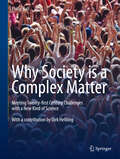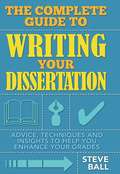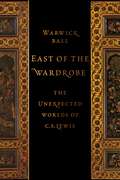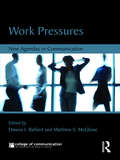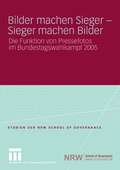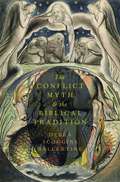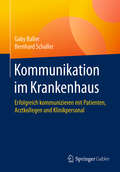- Table View
- List View
Why Society is a Complex Matter: Meeting Twenty-first Century Challenges with a New Kind of Science
by Philip BallSociety is complicated. But this book argues that this does not place it beyond the reach of a science that can help to explain and perhaps even to predict social behaviour. As a system made up of many interacting agents – people, groups, institutions and governments, as well as physical and technological structures such as roads and computer networks – society can be regarded as a complex system. In recent years, scientists have made great progress in understanding how such complex systems operate, ranging from animal populations to earthquakes and weather. These systems show behaviours that cannot be predicted or intuited by focusing on the individual components, but which emerge spontaneously as a consequence of their interactions: they are said to be ‘self-organized’. Attempts to direct or manage such emergent properties generally reveal that ‘top-down’ approaches, which try to dictate a particular outcome, are ineffectual, and that what is needed instead is a ‘bottom-up’ approach that aims to guide self-organization towards desirable states.This book shows how some of these ideas from the science of complexity can be applied to the study and management of social phenomena, including traffic flow, economic markets, opinion formation and the growth and structure of cities. Building on these successes, the book argues that the complex-systems view of the social sciences has now matured sufficiently for it to be possible, desirable and perhaps essential to attempt a grander objective: to integrate these efforts into a unified scheme for studying, understanding and ultimately predicting what happens in the world we have made. Such a scheme would require the mobilization and collaboration of many different research communities, and would allow society and its interactions with the physical environment to be explored through realistic models and large-scale data collection and analysis. It should enable us to find new and effective solutions to major global problems such as conflict, disease, financial instability, environmental despoliation and poverty, while avoiding unintended policy consequences. It could give us the foresight to anticipate and ameliorate crises, and to begin tackling some of the most intractable problems of the twenty-first century.
The Complete Guide To Writing Your Dissertation: Advice, techniques and insights to help you enhance your grades
by Steve BallIf you are studying at undergraduate or masters level it's likely that you will have to write a dissertation, critical essay or project report before you can graduate. Unfortunately, many good pieces of student research and inquiry are devalued - and sometimes even fail - because they are badly planned, structured or written. Make all that hard work count! This new guide looks directly at the processes, techniques and objectives of writing the dissertation itself. It covers longer term aspects - such as planning, scheduling, structuring - and more immediate ones - such as style, detail and managing the length. - Learn how to understand and decode the academic language of research questions, learning outcomes, objectives and assessment criteria, and translate them into the right form of words. - Discover how to maintain that essential focus on your objectives and research question or hypothesis, and their connection to your discussion and eventual conclusions. - Develop a schedule, identifying the tasks and milestones that will keep you on track, and update the plan as you go. - Find a style and structure that will help shape your writing to satisfy the examiners. - Manage the overall length and chapter lengths, and learn how to cut excess content and avoid repetition. - Master the technicalities of dissertation writing, such as methodologies, literature reviews, note systems, referencing...- Learn to how to transform an adequate dissertation into a good one by attending to fluency and detail - grammar, accuracy, consistency, punctuation - and the controlled use of aids such as spellcheckers and style checkers. - Avoid plagiarism and other evils. How can you avoid falling into cheating, either by accident or by carelessness under pressure? With examples and self-checking exercises to help you to stay on the right track, this essential guide will also serve as a valuable aid to all types of academic writing.
East of the Wardrobe: The Unexpected Worlds of C. S. Lewis
by Warwick BallA fascinating look at the rich but under-appreciated Eastern sources behind the Narnia book C. S. Lewis was no great traveller but he was a prodigious bibliophile who absorbed the world's traditions of myth, religion, and cosmology. The Chronicles of Narnia are steeped in allusions to the Bible, Greek mythology, and medieval literature, all of which has been amply discussed by critics. But, until now, what has been overlooked are Lewis' significant borrowings from Eastern influences: Arabian Nights and the Persian poets, great travellers from Herodotus and Marco Polo to T. E. Lawrence and Robert Byron, and the famous fictional adventurers Baron Munchausen, Gulliver, and Sindbad. In East of the Wardrobe, Warwick Ball explores hitherto unrecognised and unexpected Eastern aspects in and influences on C. S. Lewis' Narnia books. These include storylines, themes, imagery, religious elements, and even the cities and landscapes of the East, as well as the 'Persian' style adopted by the illustrator of Narnia, Pauline Baynes. Themes borrowed from the great epics can also be found, from The Odyssey and Aeneid to the Kalevala and The Knight in the Panther's Skin. Delve deeper and Christianity is there along with paganism, but so too are Zoroastrian, Manichaean, and even Islamic and Sufi messages. Ultimately, these influences act as a reflection of the complex intellectual world that Lewis inhabited, of both his own unique philosophy and the wider social and intellectual climate of Oxford in the first half of the twentieth century. All readers of Lewis will find in East of the Wardrobe surprising new paths into the world of Narnia.
East of the Wardrobe: The Unexpected Worlds of C. S. Lewis
by Warwick BallA fascinating look at the rich but under-appreciated Eastern sources behind the Narnia book C. S. Lewis was no great traveller but he was a prodigious bibliophile who absorbed the world's traditions of myth, religion, and cosmology. The Chronicles of Narnia are steeped in allusions to the Bible, Greek mythology, and medieval literature, all of which has been amply discussed by critics. But, until now, what has been overlooked are Lewis' significant borrowings from Eastern influences: Arabian Nights and the Persian poets, great travellers from Herodotus and Marco Polo to T. E. Lawrence and Robert Byron, and the famous fictional adventurers Baron Munchausen, Gulliver, and Sindbad. In East of the Wardrobe, Warwick Ball explores hitherto unrecognised and unexpected Eastern aspects in and influences on C. S. Lewis' Narnia books. These include storylines, themes, imagery, religious elements, and even the cities and landscapes of the East, as well as the 'Persian' style adopted by the illustrator of Narnia, Pauline Baynes. Themes borrowed from the great epics can also be found, from The Odyssey and Aeneid to the Kalevala and The Knight in the Panther's Skin. Delve deeper and Christianity is there along with paganism, but so too are Zoroastrian, Manichaean, and even Islamic and Sufi messages. Ultimately, these influences act as a reflection of the complex intellectual world that Lewis inhabited, of both his own unique philosophy and the wider social and intellectual climate of Oxford in the first half of the twentieth century. All readers of Lewis will find in East of the Wardrobe surprising new paths into the world of Narnia.
Work Pressures: New Agendas in Communication (New Agendas in Communication Series)
by Dawna Ballard Matthew McGloneWork Pressures fills the void of research on the nature of pressures on individuals in the workplace. It offers a broad view of how work pressures can compromise the performance and vitality of individuals and their organizations. The contributions to this volume not only confirm communication’s centrality to the problems work pressures pose, but also open an interdisciplinary conversation about how to learn from and, ultimately, manage them. Specific topics covered include the proliferation of communication technologies, organizational discourse, work overload, and generational differences in the workplace.
Work Pressures: New Agendas in Communication (New Agendas in Communication Series)
by Dawna Ballard Matthew McGloneWork Pressures fills the void of research on the nature of pressures on individuals in the workplace. It offers a broad view of how work pressures can compromise the performance and vitality of individuals and their organizations. The contributions to this volume not only confirm communication’s centrality to the problems work pressures pose, but also open an interdisciplinary conversation about how to learn from and, ultimately, manage them. Specific topics covered include the proliferation of communication technologies, organizational discourse, work overload, and generational differences in the workplace.
The Frameworks of English: Introducing Language Structures (PDF)
by Kim BallardHow does language work? What are the different elements? How do they all fit together? The Frameworks of English is a step-by-step guide through the various levels of language, describing the morphological, lexical, grammatical and phonological frameworks of contemporary English in a clear and logical way. Beginning with words as the building blocks of language, it investigates their internal structure and shows how words can be combined into larger and larger units, from phrases to sentences and beyond. The sound system of language is explored, covering the production of individual sounds as well asthe features of syllable structure and connected speech. The third edition of this popular textbook: * features a new chapter on how to approach accent and dialect variation in English throughout the world * includes both spoken and written examples of electronically mediated language * offers updated suggestions for further reading and research * contains an expanded glossary of linguistic terminology to aid study With plenty of exercises and helpful cross-referencingThe Frameworks of English covers everything that you need to know about linguistic structures.
The Frameworks of English: Introducing Language Structures
by Kim BallardHow does language work? What are the different elements? How do they all fit together? The Frameworks of English is a step-by-step guide through the various levels of language, describing the morphological, lexical, grammatical and phonological frameworks of contemporary English in a clear and logical way. Beginning with words as the building blocks of language, it investigates their internal structure and shows how words can be combined into larger and larger units, from phrases to sentences and beyond. The sound system of language is explored, covering the production of individual sounds as well as the features of syllable structure and connected speech. The third edition of this popular textbook:• features a new chapter on how to approach accent and dialect variation in English throughout the world• includes both spoken and written examples of electronically mediated language• offers updated suggestions for further reading and research
The Frameworks of English: Introducing Language Structures
by Kim BallardHow does language work? What are the different elements? How do they all fit together? The Frameworks of English is a step-by-step guide through the various levels of language, describing the morphological, lexical, grammatical and phonological frameworks of contemporary English in a clear and logical way. Beginning with words as the building blocks of language, it investigates their internal structure and shows how words can be combined into larger and larger units, from phrases to sentences and beyond. The sound system of language is explored, covering the production of individual sounds as well as the features of syllable structure and connected speech. The third edition of this popular textbook: features a new chapter on how to approach accent and dialect variation in English throughout the world includes both spoken and written examples of electronically mediated language offers updated suggestions for further reading and researchThe Frameworks of English is a step-by-step guide through the various levels of language, describing the morphological, lexical, grammatical and phonological frameworks of contemporary English in a clear and logical way. Beginning with words as the building blocks of language, it investigates their internal structure and shows how words can be combined into larger and larger units, from phrases to sentences and beyond. The sound system of language is explored, covering the production of individual sounds as well as the features of syllable structure and connected speech.
The Frameworks of English: Introducing Language Structures
by Kim BallardHow does language work? What are the different elements? How do they all fit together? The Frameworks of English is a step-by-step guide through the various levels of language, describing the morphological, lexical, grammatical and phonological frameworks of contemporary English in a clear and logical way. Beginning with words as the building blocks of language, it investigates their internal structure and shows how words can be combined into larger and larger units, from phrases to sentences and beyond. The sound system of language is explored, covering the production of individual sounds as well as the features of syllable structure and connected speech. The third edition of this popular textbook: features a new chapter on how to approach accent and dialect variation in English throughout the world includes both spoken and written examples of electronically mediated language offers updated suggestions for further reading and researchThe Frameworks of English is a step-by-step guide through the various levels of language, describing the morphological, lexical, grammatical and phonological frameworks of contemporary English in a clear and logical way. Beginning with words as the building blocks of language, it investigates their internal structure and shows how words can be combined into larger and larger units, from phrases to sentences and beyond. The sound system of language is explored, covering the production of individual sounds as well as the features of syllable structure and connected speech.
Interpreting Texts
by Kim BallardRoutledge A Level English Guides equip AS and A2 Level students with the skills they need to explore, evaluate and enjoy English. Books in the series are built around the various skills specified in the assessment objectives (AOs) for all AS and A2 Level English courses.Focusing on the AOs most relevant to their topic, the books help students to develop their knowledge and abilities through analysis of lively texts and contemporary data. Each book in the series covers a different area of language and literary study, and offers accessible explanations, examples, exercises, summaries, a glossary of key terms and suggested answers. Interpreting Texts:* breaks down the barriers which often inhibit the interpretation of texts* explores a wide variety of literary and non-literary examples* covers key skills and topics including discourse, intertextuality and theoretical approaches* guides the reader through the literary, social and cultural aspects of text* can be used as both a course stimulus and a revision tool.Written by an experienced teacher and AS and A2 Level examiner, Interpreting Texts is an essential resource for students of AS and A2 Level.
Interpreting Texts
by Kim BallardRoutledge A Level English Guides equip AS and A2 Level students with the skills they need to explore, evaluate and enjoy English. Books in the series are built around the various skills specified in the assessment objectives (AOs) for all AS and A2 Level English courses.Focusing on the AOs most relevant to their topic, the books help students to develop their knowledge and abilities through analysis of lively texts and contemporary data. Each book in the series covers a different area of language and literary study, and offers accessible explanations, examples, exercises, summaries, a glossary of key terms and suggested answers. Interpreting Texts:* breaks down the barriers which often inhibit the interpretation of texts* explores a wide variety of literary and non-literary examples* covers key skills and topics including discourse, intertextuality and theoretical approaches* guides the reader through the literary, social and cultural aspects of text* can be used as both a course stimulus and a revision tool.Written by an experienced teacher and AS and A2 Level examiner, Interpreting Texts is an essential resource for students of AS and A2 Level.
The Stories of Linguistics: An Introduction To Language Study Past And Present (PDF)
by Kim BallardWhat is the nature of human language? How did it originate? How did it come to be so diverse and what are the connections between the thousands of global languages? How do we learn language? Stories of Linguistics explores the people, ideas and events that have shaped linguistic thought and research for more than two thousand years.
The Stories of Linguistics: An Introduction to Language Study Past and Present
by Kim BallardWhat is the nature of human language? How did it originate? How are different languages connected?Exploring over two thousand years of human enquiry, The Stories of Linguistics is an accessible introduction to the individuals, ideas and events that have shaped the field of linguistics. From Herodotus to Chomsky, and from philosophy to neuroscience, Kim Ballard presents a fascinating narrative that brings to life a dynamic subject with a rich history. The Stories of Linguistics:uses a thematic rather than a traditional chronological approach to explore the complex development of Western linguistics offers an accessible introduction to a field of linguistics which is attracting more and more interestguides readers seamlessly through linguistic history, supported by timelines and suggestions for further reading and researchWith its broad scope and conversational style, The Stories of Linguistics is an ideal introductory text for students at every level, as well as anyone else with an interest in the history and development of language.
The History of British Women's Writing, 1690 - 1750: Volume Four (History of British Women's Writing)
by Ros BallasterThis volume charts the most significant changes for a literary history of women in a period that saw the beginnings of a discourse of 'enlightened feminism'. It reveals that women engaged in forms old and new, seeking to shape and transform the culture of letters rather than simply reflect or respond to the work of their male contemporaries.
Seductive Forms: Women's Amatory Fiction from 1684 to 1740
by Ros BallasterHistoricist and feminist accounts of the `rise of the novel' have neglected the phenomenon of the professional woman writer in England prior to the advent of the sentimental novel in the 1740s. Seductive Forms explores the means by which the three leading Tory women novelists of the late seventeenth and early eighteenth centuries challenged and reworked both contemporary gender ideologies and generic convention. The seduction plot provided Aphra Behn, Delarivier Manley, and Eliza Haywood with a vehicle for dramatizing their own appropriation of the `masculine' power of fiction-making. Seduction is employed in these fictions as a metaphor for both novelistic production (the seduction of the reader by the writer) and party political machination (the seduction of the public by the politician). This challenging and lively book also explores the debts early prose fiction owed to French seventeenth-century models of fiction-writing and argues that Behn, Manley, and Haywood succeed in producing a distinctively `English' and female `form' for the amatory novel.
Trauma and Literature in an Age of Globalization
by Jennifer BallengeeWhile globalization is often associated with economic and social progress, it has also brought new forms of terrorism, permanent states of emergency, demographic displacement, climate change, and other "natural" disasters. Given these contemporary concerns, one might also view the current time as an age of traumatism. Yet what—or how—does the traumatic event mean in an age of global catastrophe? This volume explores trauma theory in an age of globalization by means of the practice of comparative literature. The essays and interviews in this volume ask how literary studies and the literary anticipate, imagine, or theorize the current global climate, especially in an age when the links between violence, amorphous traumatic events, and economic concerns are felt increasingly in everyday experience. Trauma and Literature in an Age of Globalization turns a literary perspective upon the most urgent issues of globalization—problems of borders, language, inequality, and institutionalized violence—and considers from a variety of perspectives how such events impact our lived experience and its representation in language and literature.
Trauma and Literature in an Age of Globalization
by Jennifer Ballengee David KelmanWhile globalization is often associated with economic and social progress, it has also brought new forms of terrorism, permanent states of emergency, demographic displacement, climate change, and other "natural" disasters. Given these contemporary concerns, one might also view the current time as an age of traumatism. Yet what—or how—does the traumatic event mean in an age of global catastrophe? This volume explores trauma theory in an age of globalization by means of the practice of comparative literature. The essays and interviews in this volume ask how literary studies and the literary anticipate, imagine, or theorize the current global climate, especially in an age when the links between violence, amorphous traumatic events, and economic concerns are felt increasingly in everyday experience. Trauma and Literature in an Age of Globalization turns a literary perspective upon the most urgent issues of globalization—problems of borders, language, inequality, and institutionalized violence—and considers from a variety of perspectives how such events impact our lived experience and its representation in language and literature.
Bilder machen Sieger - Sieger machen Bilder: Die Funktion von Pressefotos im Bundestagswahlkampf 2005 (Studien der NRW School of Governance)
by Moritz BallensiefenMachen sich Journalisten selbst zu Wahlkampfhelfern? Kommentieren Sie mit ihrer Bilderauswahl das politische Geschehen anstatt zu informieren? Tageszeitungen haben längst auf die veränderte Informationsaufnahme ihrer Leser reagiert. Ohne Visualisierung keine Nachricht. Daraus hat sich eine journalistische Jagd auf möglichst spektakuläre und exklusive Bildmotive entwickelt. Moritz Ballensiefen geht im Medienwahlkampf 2005 inhaltsanalytisch auf Spurensuche nach journalistischen Darstellungsmustern.
The Conflict Myth and the Biblical Tradition
by Debra Scoggins BallentineThere are many ancient West Asian stories that narrate the victory of a warrior deity over an enemy, typically a sea-god or sea dragon, and his rise to divine kingship. In The Conflict Myth and the Biblical Tradition, Debra Scoggins Ballentine analyzes this motif, arguing that it was used within ancient political and socio-religious discourses to bolster particular divine hierarchies, kings, institutions, and groups, as well as to attack others. Situating her study of the conflict topos within contemporary theorizations of myth by Bruce Lincoln, Russell McCutcheon, and Jonathan Z. Smith, Ballentine examines narratives of divine combat and instances of this conflict motif. Her study cuts across traditional disciplinary boundaries as well as constructed time periods, focusing not only on the Hebrew Bible but also incorporating Mesopotamian, early Jewish, early Christian, and rabbinic texts, spanning a period of almost three millennia - from the eighteenth century BCE to the early middle ages CE. The Conflict Myth and the Biblical Tradition advances our understanding of the conflict topos in ancient west Asian and early Jewish and Christian literatures and of how mythological and religious ideas are used both to validate and render normative particular ideologies and socio-political arrangements, and to delegitimize and invalidate others.
The Conflict Myth and the Biblical Tradition
by Debra Scoggins BallentineThere are many ancient West Asian stories that narrate the victory of a warrior deity over an enemy, typically a sea-god or sea dragon, and his rise to divine kingship. In The Conflict Myth and the Biblical Tradition, Debra Scoggins Ballentine analyzes this motif, arguing that it was used within ancient political and socio-religious discourses to bolster particular divine hierarchies, kings, institutions, and groups, as well as to attack others. Situating her study of the conflict topos within contemporary theorizations of myth by Bruce Lincoln, Russell McCutcheon, and Jonathan Z. Smith, Ballentine examines narratives of divine combat and instances of this conflict motif. Her study cuts across traditional disciplinary boundaries as well as constructed time periods, focusing not only on the Hebrew Bible but also incorporating Mesopotamian, early Jewish, early Christian, and rabbinic texts, spanning a period of almost three millennia - from the eighteenth century BCE to the early middle ages CE. The Conflict Myth and the Biblical Tradition advances our understanding of the conflict topos in ancient west Asian and early Jewish and Christian literatures and of how mythological and religious ideas are used both to validate and render normative particular ideologies and socio-political arrangements, and to delegitimize and invalidate others.
Kommunikation im Krankenhaus: Erfolgreich kommunizieren mit Patienten, Arztkollegen und Klinikpersonal
by Gaby Baller Bernhard SchallerDas Buch beschreibt Theorie und Praxis der Kommunikation im Krankenhausalltag zwischen den verschiedenen Berufsgruppen. Dabei wird sowohl die Verständigung unter Kollegen, die Arzt-Patientenkommunikation als auch die Darstellung nach außen hin betrachtet. Zahlreiche Praxisbeispiele ergänzen die Ausführungen. Viele Hinweise und nützliche Tipps für gelingende Gespräche, die Nutzung technischer Kommunikationsmittel im Krankenhausbetrieb, eine Take-Home-Message am Ende jedes Kapitels sowie viele Schaubilder und Checklisten machen das Buch zu einem handlichen Nachschlagewerk für alle Berufsgruppen, die in einem Krankenhaus tätig sind.
E.T. Talk: How Will We Communicate with Intelligent Life on Other Worlds? (Astronomers' Universe)
by Fernando J. BallesterosFor a long time I have been giving scientific lectures in different countries and on diverse topics, generally related to astronomy and to my work at the Arecibo Observatory. No matter which parti- lar topic I am talking about, the same question always comes up: Have we had any contact at Arecibo with “them”? My negative answer does not satisfy anyone. In fact, the answer either confirms their suspicions that there is a conspiracy afoot by higher autho- ties not to release information or their intentions to deceive the general public. The reasons for the deception have to do with the idea that, as in the movie Contact, the received messages contain important and useful information that will bring great advantage to whoever gets it. Many of us want to believe that extraterrestrial creatures can talk to us, that perhaps they are even living among us, as UFO fans believe. It would be fascinating if it were true, a more than extra- dinary discovery, the answer to an eternal question. There is p- sibly a deep psychological motive in this desire to know if we are alone in this huge universe, and the need to believe in something beyond our limited world, in space and time. There is no doubt, then, that this topic brings with it many scientific and philosophical discussions, as well as speculations that, on many occasions, fall into pure pseudoscience because of the lack of a reference framework.
W. B. Yeats: A Census of the Manuscripts (Routledge Library Editions: W. B. Yeats)
by Conrad A. Balliet Christine MawhinneyThis title, first published in 1990, is a census of the manuscripts of William Butler Yeats. The census includes not only his books, plays and poetry but also the whereabouts of many of Yeats’s letters and speeches, and will be of particular interest to students of literature. For further reading please refer to Conrad A. Balliet’s chapter ‘A Supplement to W. B. Yeats: A Census of the Manuscripts’ in Richard J. Finnerman’s (Editor) Yeats: An Annual of Critical and Textual Studies (Volume XIII, 1995, The University of Chicago Press).
W. B. Yeats: A Census of the Manuscripts (Routledge Library Editions: W. B. Yeats)
by Conrad A. Balliet Christine MawhinneyThis title, first published in 1990, is a census of the manuscripts of William Butler Yeats. The census includes not only his books, plays and poetry but also the whereabouts of many of Yeats’s letters and speeches, and will be of particular interest to students of literature. For further reading please refer to Conrad A. Balliet’s chapter ‘A Supplement to W. B. Yeats: A Census of the Manuscripts’ in Richard J. Finnerman’s (Editor) Yeats: An Annual of Critical and Textual Studies (Volume XIII, 1995, The University of Chicago Press).
